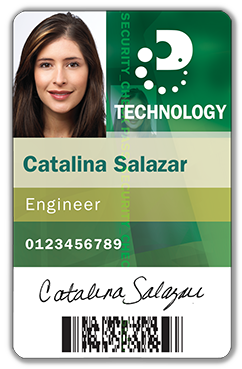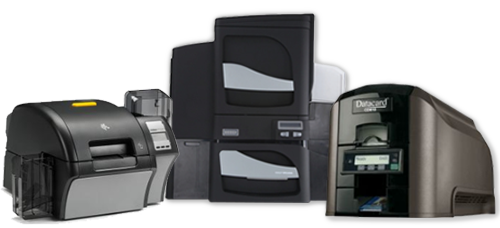
Most of us aren’t graphic designers in “real life.” That’s why when you decide to start an ID card issuance program, it’s important to first consider a few of things about what you want your ID card design to look like. By mapping out what you want your card design to look like before you start shopping for an ID card printer, you’ll not only save time but you may even save money. In addition, you can better determine which type of printer will best serve you, based on your card layout specifications.
Will you have print on both sides of the card? Do you want your cards to be full-color or simply a single color? Does your card design need to have the color extend all the way to the card’s edge? OK…hold the phone…let’s cover the primary printing scenarios:
#1: Cost Per Card
For the lowest cost-per-print card price, monochrome (single color) printers are primarily used when printing on a colored PVC card (white ink on a black or solid color card) or when you want to print text on pre-printed cards.
#2: Standard Issue
The most common style of credential is a full-color ID card. These types of cards generally feature a combination of elements like photos, logos, text, barcodes, and more. Most color printers can also use a monochrome ribbon if you’re looking to print a variety of different card styles.
#3: Basic ID Cards
If you can get all of your data and details on one side of the card, a single-sided printer will probably be the right option for you. As an added bonus, the single-sided printing style saves you money, because you’re only printing on one side of your card. Some single-sided ID card printers are capable of upgrading from single-sided to dual-sided. With this kind of flexibility, you’ll have a great starting point if you’re new to the ID card printing world and your card issuance program expands over time.
#4: Advanced ID Cards
For a larger initial investment, a dual-sided printer will be best if you have a substantial amount of content you want to feature on both sides of your cards. Some organizations require a substantial amount of information:
- standard data (employee name, title, department or division, etc.)
- company name and logo
- company policy

- barcodes
- other branding elements
- certifications
This can be the best way to go in order to aesthetically fit all of their information without scrunching it all onto a single side. Although it will cost more than a single-sided printer and the cost per card will also increase, you’ll have more real estate for information about the cardholder. For folks in the medical industry, having the same content on both sides of ID cards is mandatory so that the information is easily displayed, regardless of which side its on.
#5: High-quality ID Cards
As the prevalent type of ID card printing, direct-to-card printers (also called “dye sublimation” printers) use a thermal printhead to transfer color from ribbon to the surface of a card. These printers use standard ribbon supplies and print photo-realistic colors with a slight border around the card. Many of the cards printed with direct-to-card printers look as good as their borderless peers.
#6: Superior-quality ID Cards
On the other hand, retransfer printers (also called “reverse transfer” printers) are the optimal choice for users who want the highest quality images and colors displayed on their cards. These printers go all the way to the very edge of ID cards, so printing with them is referred to as “full-bleed printing.” Because of the more complex printing process, printing speeds are generally slower than direct-to-card printers. However, retransfer printers are the creme de la creme when it comes to producing the most vivid, professional-looking colors and exceptionally crisp text and barcodes.
The retransfer printers have a printhead that does not come into direct contact with a card’s surface. Instead, the ink from the ribbon is printed on the reverse side of a clear film and is then sandwiched between the film and the surface of the card. The cost per card is a bit higher because of the extra film that’s required during printing; however, cards are ultimately more durable and will subsequently last longer (saving you money down the road). Retransfer printers are also the #1 choice when printing on uneven surfaces like proximity cards, smart cards, and proximity key tags.
Although we readily understand that this can be a great deal of information to digest, you don't need to waste your time feeling overwhelmed or confused about where to start when designing ID cards. You can always call a knowledgeable ID Professional to help guide you along the way. Call us for any and all questions you have: (800) 321-4405!
